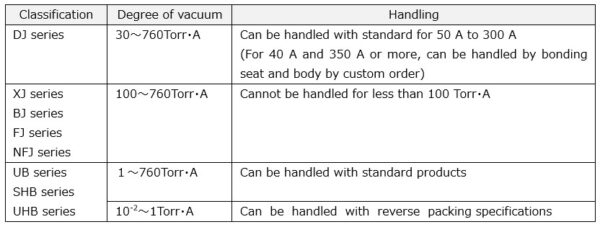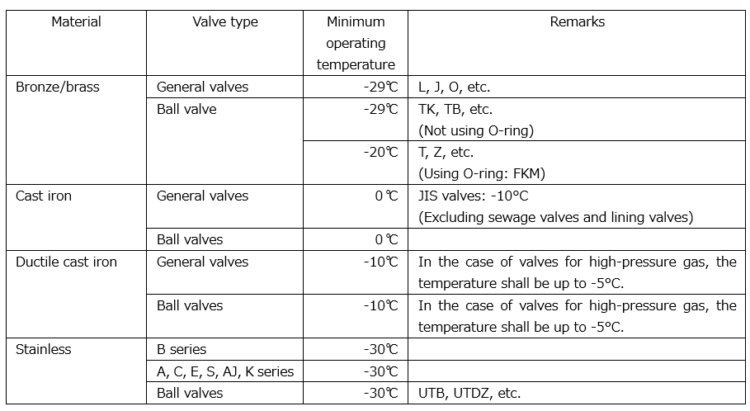Frequently Asked Questions
We have summarized the questions that you often inquire about.Please refer to it before you inquire.
See “Trouble Shooting” for information on problems.
- Detailed Search
-
Search by Product
Search by Category
Search by Keyword
- Up to what pressure can the model 400 valve be used?
-
“Model 400” indicates the pressure unit, PSI, in the United States and the valve can be used up to a maximum operating pressure of 2.75 MPa at room temperature (38°C or less).
- Up to what pressure can the model 600 valve be used?
-
“Model 600” indicates the pressure unit, PSI, in the United States and the valve can be used up to a maximum operating pressure of 4.12 MPa at room temperature (38°C or less).
- Up to what pressure can the model 800 valve be used?
-
“Model 800” indicates the pressure unit, PSI, in the United States and the valve can be used up to a maximum operating pressure of 5.49 MPa at room temperature (38°C or less).
- Up to what pressure can the model 1000 valve be used?
-
“Model 1000” indicates the pressure unit, PSI, in the United States and the valve can be used up to a maximum operating pressure of 6.86 MPa at room temperature (38°C or less).
- Tell me the series of butterfly valves according to the degree of vacuum.
-
Butterfly valves can be used based on the degree of vacuum shown in the table below as a guide.

- Tell me the specifications of ball valves according to the degree of vacuum.
-
Ball valves can be used based on the degree of vacuum shown in the table below as a guide.
We recommend the flange type, but please determine the use of the threaded type (standard product) based on your use record. (For the threaded type products, the specifications of the gland packing cannot be changed.)

- Tell me the minimum operating temperature of valves.
-
The temperature varies depending on the product and use method, but rough guides for general products are as follows.
When the temperature is below these values, it may be handled with special specifications. Please identify the use conditions, such as fluid, temperature, and pressure, and contact your dealer.
When using at minus temperature, “no freezing of fluid” is an absolute condition.
- Tell me the opening at the time of shipment from the factory of pneumatic automatic ball valves.
-
Basically, double-acting types (B type / FA type) are shipped at the fully open position and the single-acting types (BS type / FAS type) are shipped with airless.
However, this is not the case when ancillary equipment is equipped with.
- Tell me the opening at the time of shipment from the factory of electric automatic ball valves.
-
For electric ball valves, the 2-way valves are shipped at the fully open position and the 3-way valves are shipped at the rotation stop position in the counterclockwise rotation.
- Is it possible to use bronze / brass valves for flammable gas?
-
Do not use bronze / brass valves for flammable gas or toxic gas. (The catalog clearly states that flammable gas and toxic gas are excluded.)
However, this does not apply to gas valves.Please refer to the catalog for gas valves.
(General Catalog, Digest Version_13-Gas)
- Is it possible to use a globe valve with a “half-open” state?
-
A globe valve can be used with a “half-open” state.
However, do not use it in a “half-open” or “slightly open” state that causes vibration due to the fluid.
Vibration may break the valve shaft or damage the disc or valve seat surface.
- Tell me the proper piping tightening torque for threaded products.
-
The proper piping tightening torque for threaded products are as follows.
Be careful not to tighten with excessive force.
- What is chattering?
-
Chattering is a phenomenon in which the valve disc of a check valve hits the seat surface of the valve casing or the valve disc or arm hits the valve casing.
Unstable fluid flow such as fluctuations in flow velocity, turbulence and pulsation may cause chattering due to unstable opening of the valve disc.
- What flow rate (flow velocity) is required to keep the disc opening of a check valve above a certain level?
-
A rough guide for the average flow velocity in the pipe required to keep the disc at a constant opening is as follows for a swing type check valve.
“For water”: 1 – 3 m/s
“For gas”: About 30 – 50 m/s when the pressure is about 100 KPaG with normal temperature air
A check valve may cause chattering even if the flow velocity is too slow or too fast, shortening the service life of the valve.
We recommend to select the valve size so that an appropriate flow velocity can be obtained.
- What is water hammer?
-
Water hammer is a phenomenon in which the momentum of water in a water pipe changes in a short period of time and an abnormally large pressure wave is generated in the pipe. The cause is ① sudden opening / closing of the valve or ② sudden start / stop of the pump. When water hammer occurs, not only the valve may be damaged, but also the devices, etc. connected to the piping may be damaged. Therefore, it is necessary to pay attention to water hammer. As a countermeasure, close the valve as slowly as possible. Alternatively, we recommend that you consider a wafer type check valve or counterweight type check valve.
- Tell me the difference between gauge pressure and absolute pressure.
-
Gauge pressure is the pressure using the atmospheric pressure as the reference (0).
The unit display is G”, but it is often omitted.
The conversion formula from absolute pressure is [Gauge pressure = Absolute pressure – Atmospheric pressure].Absolute pressure is the pressure using an absolute vacuum pressure as the reference (0).
The unit display is A” or ”Abs”, but it is often omitted.
The conversion formula from gauge pressure is [Absolute pressure = Gauge pressure+ Atmospheric pressure].
Contact us
For inquiries about product technology, product purchases,
catalogs, and quality
